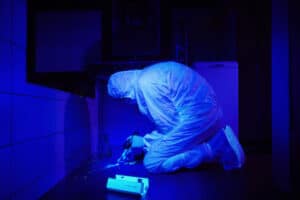Why UV Lenses Are Essential In Forensic Applications
In many fields, forensics is a vital tool. It is primarily to improve public safety by applying science to criminal investigations. Accurate forensics is also crucial in identifying criminals at crime scenes and putting together the puzzle pieces. The best forensic tools are needed by forensic teams. UV lenses are the perfect tool when the best tools is required.

UV Lenses Essential In Forensic
Uses of UV lenses in law enforcement
Evidence collection is crucial after a crime to establish the facts and identify possible suspects. In the past, law enforcement and detectives relied heavily on their eye-sight and inadequate evidence collection methods. Lifting fingerprints using tape can lead to mistakes or omissions even if they are unintentional.
UV Lenses Play A Role In Crime Scene Investigation
UV imaging is a great solution for detectives or crime scene investigators who need to reach deep into the ultraviolet spectrum to capture images of evidence that are not possible with traditional cameras.
Portable lamps are most commonly used in the forensics industry to generate wavelengths between 320 NM and 400 NM.
The wavelength reveals clues that otherwise would not be detected. Many materials, for example, fluoresce under UV light. UV imaging allows the detection and visualization of bodily fluids such as semen, saliva, blood and more.
Fluorescent and Reflective UV Imaging
The two main types of ultraviolet imaging are fluorescent and reflective. In reflective imaging, an object is illuminated by UV light and captured with a camera that has a UV sensitive lens. This type of imaging is used to examine large objects such as furniture, flooring, walls or vehicles for evidence.
Before illuminating the object, the investigator covers it with fluorescent powder. The powder absorbs UV and emits visible light. The camera then captures the visible light, and projects the image onto the screen. Fluorescent imaging can be used to examine smaller objects such as clothing fibers or paper.
RUVIS is used by law enforcement to detect bloodstains not discovered during the initial investigation of a crime scene.
RUVIS uses a UV light source of high intensity to illuminate a surface, then a camera is used to capture the images reflected from the surface. The team of investigators stores the images on a computer to be analyzed. These images, when used as solid proof, can help convict criminals.
In the lab, fluorescent imaging is used to examine evidence in greater detail. For instance, fluorescent microscopy is used to examine fibers or hairs in order to determine the type. The information can be used by prosecutors to narrow the pool of suspects.
There are many different types of UV lenses available, each with a specific application.
Some lenses are more suitable for crime scene investigations, while others work better for laboratory analyses. To get the best UV lens for your needs, you must choose the correct one.
Closing Cold Cases
Unfortunately, many crimes remain unsolved. Many crimes go unsolved due to a variety of reasons, including lack of evidence or improper handling of evidence.
As technology improves, the chances of solving a cold case increase. Cold case investigators are able to resubmit the evidence they collected for analysis with a UV-based lens. Using forensic technology and greater access to DNA databases has allowed for perpetrators to be identified, even years after they committed the crime.
This can bring closure to the families and loved-ones of victims of crimes that have not been solved.
Reverse Wrongful Convictions
It is not only possible to solve cold cases with forensic evidence, but also exonerate those convicted for crimes they didn’t commit. Wrongful convictions can lead to innocent people facing years of prison or even the death penalty.
This is because traditional evidence such as eyewitness testimonies can be notoriously unreliable. DNA evidence, on the other hand, is a reliable method of identifying the perpetrators of crimes. In order to restore justice, DNA forensics has been used to overturn wrongful convictions.
DNA forensic evidence can be a powerful tool in the battle against wrongful convictions.
UV Lenses and the Future of Forensics
Criminal investigators and law enforcers will have more tools at their disposal as technology advances.
At SUPERIOR® Optics, we offer a variety of UV lenses designed specifically for forensic purposes. Our UV Lens experts will help you select the best lens for your application.
Please contact us if you have any queries about our products and services.
Related Posts
Why UV Lenses Are Essential In Forensic Applications" rel="bookmark">Why UV Lenses Are Essential In Forensic Applications
How useful was this post? Click on a star to rate it! Submit Rating As you found this post useful......
How The Semiconductor Business Is Using Ultraviolet Lenses" rel="bookmark">How The Semiconductor Business Is Using Ultraviolet Lenses
How useful was this post? Click on a star to rate it! Submit Rating As you found this post useful......




